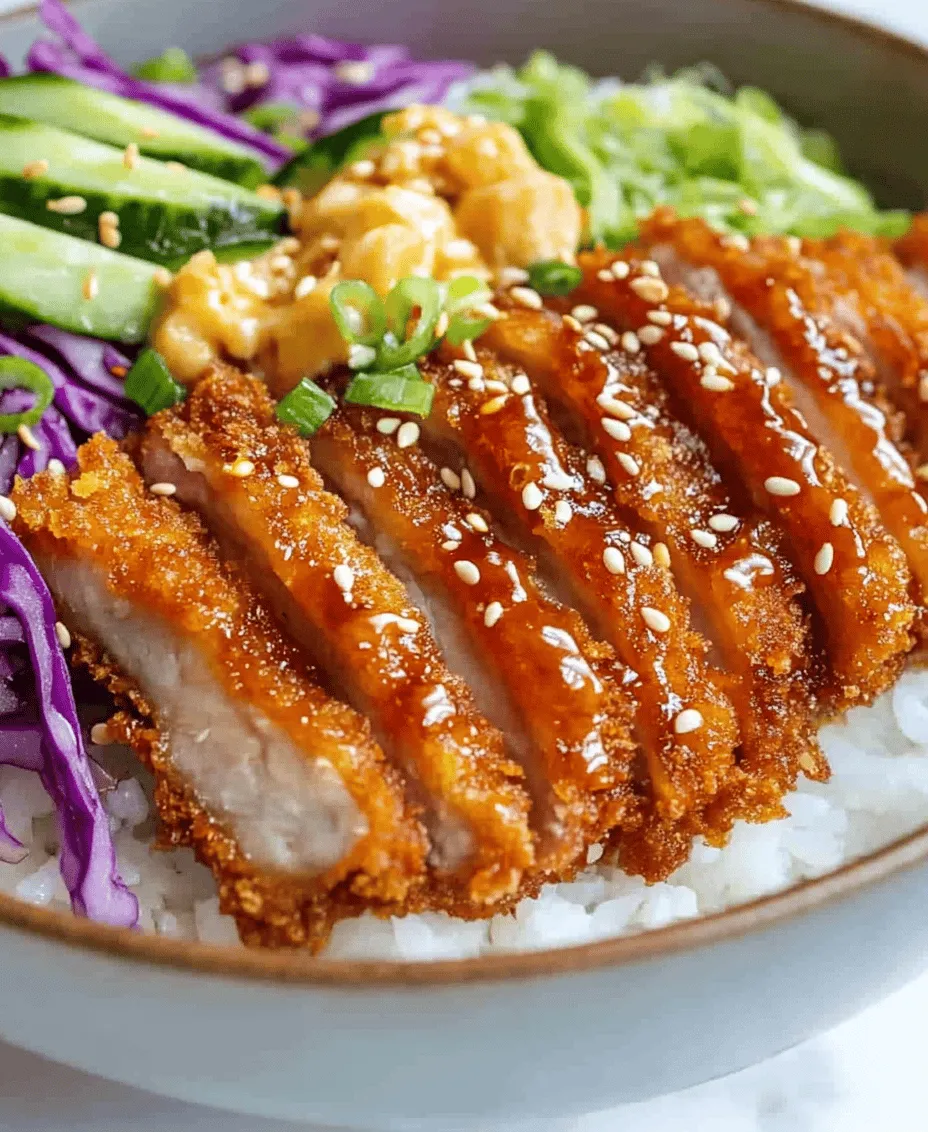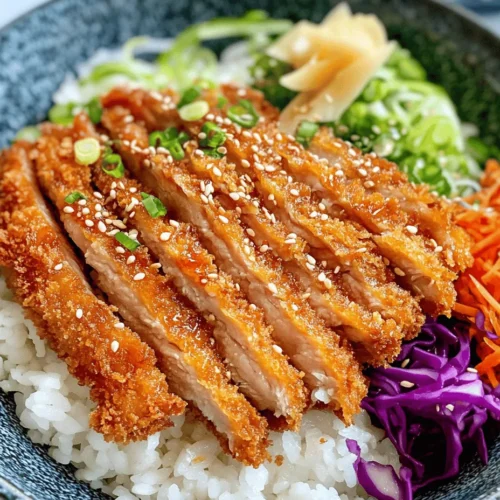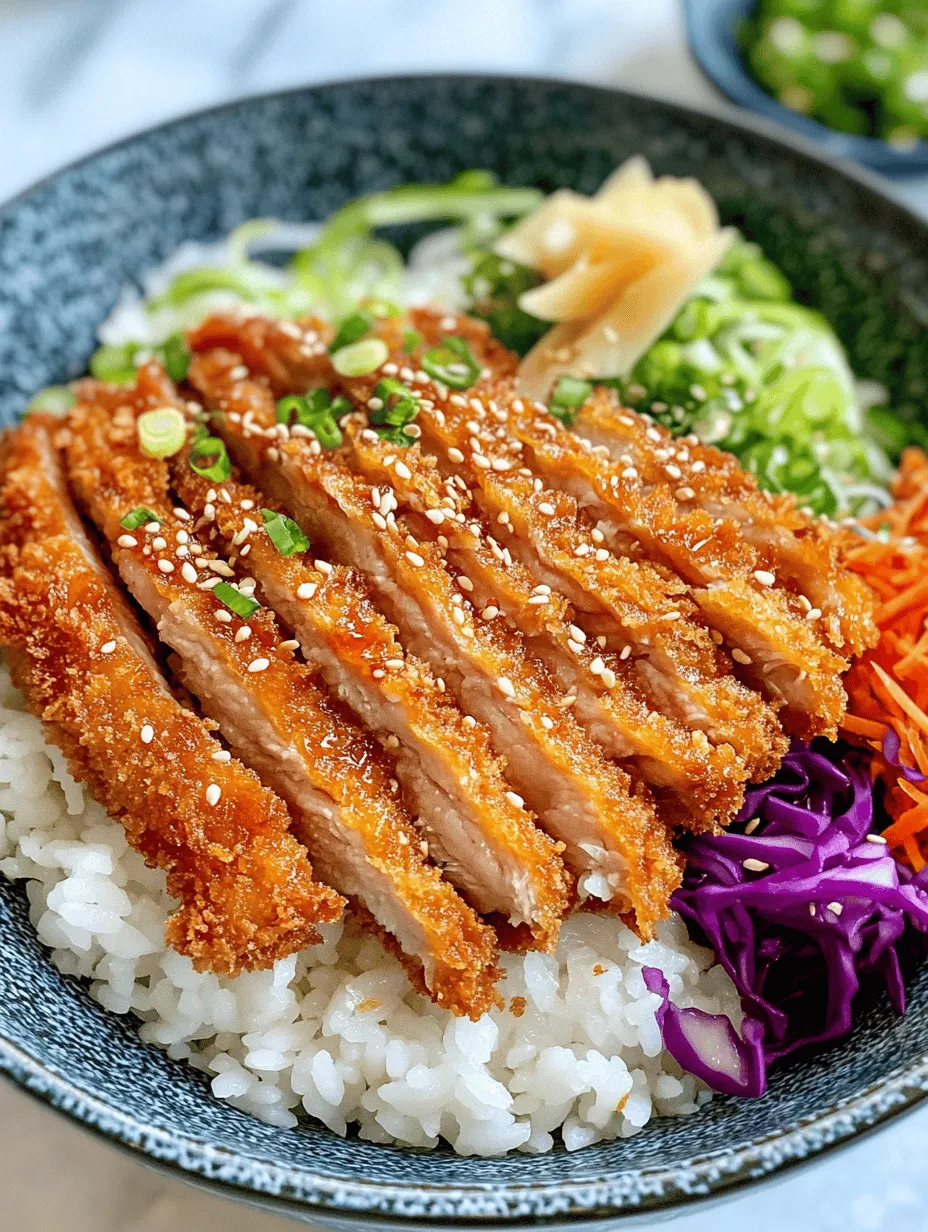Introduction
Tonkatsu, a beloved dish from Japan, has found its way into the hearts and stomachs of food lovers around the globe. Characterized by its crispy breaded exterior and tender meat, this dish combines simplicity with a complex flavor profile that is both satisfying and indulgent. In this article, we will take you through the process of creating Crispy Tonkatsu Delight, a delightful recipe that features succulent pork loin served over a bed of fluffy rice, garnished with fresh toppings, and drizzled with a rich, tangy sauce. Not only is this dish a feast for the eyes, but it also provides a fulfilling culinary experience that speaks to the heart of Japanese home cooking.
As we dive into the preparation of this dish, we will explore the origins of tonkatsu, the ingredients required, and the techniques that make this meal special. The journey begins with understanding the cultural significance of tonkatsu in Japan and how it has evolved over the years.
Understanding Tonkatsu: A Cultural Journey
Exploring the Origins of Tonkatsu
Tonkatsu originated in Japan during the late 19th century, a time when the country was opening up to Western influences. It is believed that the dish was inspired by European cutlet recipes, particularly the French “côtelettes.” The Japanese adapted this concept by using pork, which was more accessible and had a unique flavor profile that resonated with local tastes. The first recorded instance of tonkatsu appeared in Tokyo in the 1890s, quickly becoming a popular option in local restaurants.
The Evolution of Tonkatsu in Japanese Cuisine
Over the decades, tonkatsu has evolved from a Western-inspired dish to a staple of Japanese cuisine. It is commonly served in various settings, from casual eateries to high-end dining establishments, making it a versatile dish that caters to all tastes. The traditional method of preparing tonkatsu involves coating a pork cutlet in flour, egg, and Panko breadcrumbs before frying it to a golden crisp. This preparation technique allows for a delightful contrast between the crunchy exterior and the juicy interior, showcasing the skill and care that goes into Japanese cooking.
Culinary Significance of Tonkatsu in Modern Dining
In modern Japan, tonkatsu is more than just a meal; it represents comfort and home-cooked goodness. It is often served with a side of shredded cabbage, rice, and a special tonkatsu sauce, creating a well-balanced and satisfying plate. In addition, tonkatsu has inspired countless variations, including chicken katsu and vegetable katsu, further expanding its appeal. Today, tonkatsu is not only enjoyed in Japan but has also gained international popularity, with restaurants and home cooks around the world embracing this delicious dish.
Ingredients Breakdown
To create the Crispy Tonkatsu Delight, you’ll need a selection of key ingredients that work harmoniously to build the dish’s signature flavor and texture.
Highlighting the Main Ingredients in Tonkatsu
1. Pork Loin: The star of the dish, pork loin is favored for its tenderness and flavor. It is typically cut into thick slices, ensuring a juicy center that contrasts beautifully with the crispy exterior.
2. Panko Breadcrumbs: These Japanese-style breadcrumbs provide a light and airy crunch that is essential for achieving the perfect tonkatsu texture. Unlike regular breadcrumbs, Panko is made from crustless bread, resulting in larger, flakier pieces.
3. All-Purpose Flour: Flour is used to coat the pork before dipping it in egg, helping the breadcrumbs adhere and creating a protective layer that locks in moisture during frying.
4. Eggs: Beaten eggs are used as a binding agent, ensuring that the Panko adheres well to the pork and contributes to the overall crispiness.
5. Vegetable Oil: A neutral oil, such as canola or sunflower, is used for frying the tonkatsu. The oil should be hot enough to create a crispy exterior without absorbing excess oil.
6. Tonkatsu Sauce: This tangy sauce, made from a blend of Worcestershire sauce, ketchup, and various spices, enhances the flavor of the dish and adds a burst of umami.
The Role of Each Ingredient in Flavor and Texture
Each component of the tonkatsu plays a crucial role in creating the dish’s signature taste and texture. The pork loin is juicy and flavorful, while the Panko breadcrumbs create a satisfying crunch. The flour and egg work together to bind the breadcrumbs to the meat, ensuring that each bite is crispy and delicious. The tonkatsu sauce ties everything together, adding depth and complexity to the dish.
Suggestions for Ingredient Substitutions for Dietary Needs
For those with dietary restrictions or preferences, there are several substitutions that can be made while still achieving a delicious outcome:
– Pork Alternatives: For a lighter option, consider using chicken breast or tofu slices. Both can be prepared using the same technique for a delightful katsu experience.
– Gluten-Free Options: Substitute regular flour and Panko breadcrumbs with a gluten-free flour blend and gluten-free breadcrumbs to cater to gluten-sensitive individuals.
– Dairy-Free Alternatives: While tonkatsu traditionally does not contain dairy, ensure that any sauces or side dishes served with it are also dairy-free if needed.
Preparing the Tonkatsu Sauce
The tonkatsu sauce is a key element that elevates this dish to new heights. Its sweet and tangy flavors complement the richness of the fried pork, creating a harmonious balance on the palate.
The Importance of Tonkatsu Sauce in Enhancing Flavor
Tonkatsu sauce is not just a condiment; it is an integral part of the dish that enhances its overall flavor profile. The combination of sweet and savory notes helps to cut through the richness of the fried pork, making each bite a well-rounded experience. It can be drizzled over the katsu or served on the side for dipping, allowing for personal preference in flavor intensity.
Step-by-Step Guide to Making the Perfect Sauce
To make a simple yet delicious tonkatsu sauce at home, follow these steps:
1. Gather Ingredients: You will need Worcestershire sauce, ketchup, soy sauce, sugar, and a dash of mustard for a touch of heat.
2. Mix Ingredients: In a bowl, combine 1/2 cup of Worcestershire sauce, 1/4 cup of ketchup, 2 tablespoons of soy sauce, 1 tablespoon of sugar, and 1 teaspoon of mustard.
3. Whisk Together: Use a whisk to blend all the ingredients until smooth and well combined. Taste and adjust the sweetness or tanginess by adding more sugar or mustard if desired.
4. Let it Rest: Allow the sauce to sit for at least 15 minutes before serving to let the flavors meld together.
5. Store for Later: Any leftover sauce can be stored in an airtight container in the refrigerator for up to a week.
Variations of Tonkatsu Sauce and Their Unique Tastes
While the traditional tonkatsu sauce is delicious on its own, you can experiment with variations to suit your taste. Some popular options include:
– Spicy Tonkatsu Sauce: Add a teaspoon of chili paste or sriracha for a spicy kick.
– Fruit-Infused Sauce: Incorporate fruit purees like apple or peach for a sweeter, more complex flavor profile.
– Homemade Fermented Sauce: For a more authentic experience, consider fermenting your own sauce with fruits and spices for a unique twist.
Selecting the Right Pork for Tonkatsu
Choosing the right cut of pork is crucial for achieving the best tonkatsu. The quality of the meat will directly impact the flavor and tenderness of the final dish.
Choosing the Best Cuts of Pork Loin
The ideal cut for tonkatsu is pork loin, which is lean yet tender. Look for cuts that have a good balance of meat and fat, as the fat helps to keep the pork moist during cooking. Additionally, boneless pork chops or tenderloin can also work well if you prefer a different cut.
Tips for Selecting Quality Meat at the Market
When selecting pork at the market, consider the following tips:
– Look for Color: Fresh pork should have a light pink color. Avoid meat that appears gray or has dark spots.
– Check for Marbling: A little marbling (fat interspersed within the meat) is ideal, as it contributes to flavor and moisture.
– Ask Your Butcher: Don’t hesitate to ask your butcher for recommendations or for specific cuts if you’re unsure.
How to Prepare Pork for Optimal Tenderness
To ensure your pork loin is as tender as possible, consider the following preparation techniques:
– Pound the Meat: Gently pound the pork cutlets to an even thickness for more consistent cooking. This will help tenderize the meat and create a more enjoyable texture.
– Marinate (optional): For added flavor and tenderness, consider marinating the pork in a mixture of soy sauce, garlic, and ginger for about 30 minutes before breading.
Creating a Dredging Station: The Art of Breading
Breading the pork is a critical step in preparing tonkatsu. A well-organized dredging station will make the process efficient and less messy.
Setting Up an Efficient Dredging Station
To set up your dredging station, gather three shallow dishes:
1. Flour Dish: Fill one dish with all-purpose flour. This will be the first step in the dredging process.
2. Egg Dish: In the second dish, beat a couple of eggs until well combined. This will serve as the binding agent for the breadcrumbs.
3. Panko Dish: In the third dish, place a generous amount of Panko breadcrumbs. This will give the tonkatsu its signature crunch.
Arrange the dishes in order in your workspace, allowing for easy access as you bread the pork.
The Science Behind Flour, Egg, and Panko Breadcrumbs
The dredging process is more than just a cooking technique; it is a science that ensures the perfect texture for your tonkatsu. Here’s how each component plays a role:
– Flour: The flour creates a dry surface that helps the egg adhere to the pork. This initial coating also helps to create a barrier that locks in moisture during frying.
– Egg: The beaten egg acts like glue, allowing the Panko breadcrumbs to stick effectively. It also contributes to the golden color that develops during frying.
– Panko Breadcrumbs: Panko’s unique texture allows it to fry up light and crispy, providing that coveted crunch that makes tonkatsu so irresistible.
With these foundational steps completed, you are well on your way to creating a delectable Crispy Tonkatsu Delight. Stay tuned for the next part of the article, where we will delve into detailed cooking instructions, tips for achieving the perfect fry, and serving suggestions that will make your katsu bowls truly unforgettable.

Techniques for Achieving the Perfect Crust
When preparing Crispy Tonkatsu, the crust is what truly sets this dish apart. Achieving that golden, crunchy exterior can be a challenge, but with the right techniques, you can create Tonkatsu that rivals any restaurant’s. Here’s how to get it just right.
Frying the Tonkatsu: Techniques for Crispy Perfection
Understanding Oil Temperature for Frying Success
One of the most crucial aspects of frying Tonkatsu is maintaining the correct oil temperature. Ideally, you want your oil to be around 350°F (175°C) during frying. This temperature ensures that the breadcrumbs crisp up quickly without absorbing too much oil, leading to that delightful crunch. Use a deep-fry thermometer for accuracy, or perform a simple test: drop a small piece of bread into the oil. If it sizzles and rises to the surface, the oil is ready.
Tips for Frying Pork to Ensure Even Cooking
To ensure that your pork cutlet cooks evenly, it’s essential to allow the meat to rest at room temperature for about 15 minutes before frying. This step helps the meat cook more uniformly. Also, when you coat your pork with flour, egg, and panko breadcrumbs, make sure the layers are even and fully cover the meat. This not only adds texture but also prevents the meat from becoming too greasy.
How to Avoid Common Frying Mistakes
Avoid overcrowding the frying pan, as this can reduce the oil temperature and lead to soggy Tonkatsu. Fry in small batches, allowing enough space for the cutlets to bubble and crisp. Additionally, after frying, place the Tonkatsu on a wire rack instead of paper towels. This prevents steam from building up beneath the cutlet, resulting in a soggy crust.
Assembling Your Katsu Bowl
Assembling your Katsu bowl is where creativity meets culinary skill. The arrangement of your ingredients not only impacts the presentation but also the overall dining experience.
Layering the Ingredients for Visual Appeal
Start by placing a generous serving of steamed rice at the bottom of your bowl. Slice your crispy Tonkatsu into strips and lay them atop the rice, allowing the golden crust to be the star of the show. Next, add your choice of vegetables, such as shredded cabbage or pickled radish, which not only adds color but also provides a refreshing crunch.
The Importance of Balance in Flavors and Textures
In a Katsu bowl, balance is key. The rich, savory flavors of the Tonkatsu should be complemented by the brightness of the vegetables. A drizzle of tonkatsu sauce enhances the umami flavor, while a sprinkle of sesame seeds adds a nutty touch. Consider incorporating a soft-boiled egg for creaminess, which can also help to tie the flavors together.
Creative Ways to Present Your Katsu Bowl
For an Instagram-worthy presentation, consider using a bowl with vibrant colors or patterns. Layer your ingredients in a way that highlights each component, and don’t shy away from garnishing with fresh herbs like green onions or cilantro. You can also add a side of miso soup or a small dish of dipping sauce to elevate the dining experience.
Exploring Pairings and Complementary Sides
No Katsu bowl is complete without the perfect accompaniments. Traditional Japanese sides can enhance the meal and provide a well-rounded dining experience.
Traditional Japanese Sides That Enhance the Meal
Consider serving your Katsu bowl with authentic Japanese sides such as miso soup, which provides warmth and depth. A side of sunomono (vinegared cucumber salad) can offer a refreshing contrast to the richness of the Tonkatsu. Another option is edamame, which contributes a satisfying crunch and boosts the nutritional value of your meal.
Suggestions for Drinks That Pair Well with Katsu Bowls
To complement the flavors of your Katsu bowl, consider pairing it with a light beverage. Japanese green tea (matcha or sencha) is an excellent choice, as it cleanses the palate and enhances the meal’s umami notes. For something different, you might enjoy a chilled sake or even a light beer, which can cut through the richness of the fried pork.
Exploring the Flavors of Pickled Ginger and Sesame Seeds
Pickled ginger adds a zesty bite and is often served as a palate cleanser in Japanese cuisine. Its sharpness contrasts beautifully with the savory Tonkatsu. Similarly, toasted sesame seeds not only provide a pleasant crunch but also add a layer of flavor that enhances the overall dish.
Nutritional Information: A Closer Look at Katsu Bowls
As with any recipe, understanding the nutritional content can help you make informed choices about your meals. Here’s a closer look at what goes into a Katsu bowl.
Analyzing the Nutritional Content of the Main Ingredients
The primary components of a Katsu bowl—pork, rice, and vegetables—contribute various nutrients. Pork is an excellent source of protein and provides essential vitamins and minerals, such as B vitamins and iron. The rice serves as a carbohydrate source and can be substituted with brown rice for added fiber. Vegetables contribute vitamins, minerals, and antioxidants, making the dish more balanced.
Discussing Calorie Count and Health Considerations
A traditional Katsu bowl can range from 600 to 800 calories, depending on portion sizes and added ingredients. While this dish is undeniably comforting, it’s essential to enjoy it in moderation. You can lighten your Katsu bowl by using less oil during frying or opting for leaner cuts of pork.
Tips for Making Katsu Bowls a Balanced Meal
To create a more balanced meal, consider adding more vegetables or even including a side salad. You might also experiment with whole grain rice or substituting the pork with chicken or tofu for a lighter option. Balancing your Katsu bowl with protein, fiber, and healthy fats can help you enjoy this dish without compromising your dietary goals.
The Global Appeal of Tonkatsu
The allure of Tonkatsu extends far beyond Japan’s borders. Its rich flavors and satisfying textures have captured the hearts of food lovers around the world.
How Tonkatsu Has Influenced International Cuisine
Tonkatsu has inspired countless variations in international kitchens, from the popular katsu sandwiches in Hawaii to the growing trend of Katsu curry in Western restaurants. Its adaptability makes it a favorite among chefs and home cooks alike.
Variations of Tonkatsu Found in Different Cultures
Variations of Tonkatsu can be found across Asia. For instance, in Korea, a similar dish called “donkatsu” is served with a sweeter sauce and often accompanied by a side of kimchi. In the Philippines, a dish called “katsu” has emerged, featuring chicken or pork and served with a rich gravy.
The Growing Popularity of Japanese Cuisine Worldwide
As Japanese cuisine gains popularity, dishes like Tonkatsu are becoming staples in homes and restaurants around the globe. The emphasis on fresh ingredients, presentation, and balance resonates with health-conscious diners seeking new culinary experiences.
Conclusion
Crispy Tonkatsu Delight is more than just a meal; it is a reflection of Japanese culinary artistry and culture. By understanding the components and techniques involved in creating this dish, you can bring a piece of Japan into your kitchen. Embracing the simplicity and depth of flavors, Katsu bowls are perfect for both everyday dining and special occasions. Enjoy the journey of making and savoring this delicious dish! Whether you’re enjoying it on a cozy night in or serving it at a gathering, Katsu bowls are sure to impress and satisfy.



